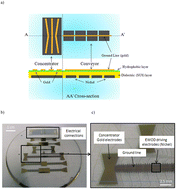Selective electrohydrodynamic concentration of waterborne parasites on a chip†
Abstract
Concentrating diluted samples is a key step to improve detection capabilities. The wise use of scaling laws shows the advantages of working with sub-microliter-sized samples. Rapid progress in MEMS technologies has driven the design of integrated platforms performing many biochemical operations. Here we report a new concentrator device based on electro-hydrodynamic forces which can be easily integrated into electrowetting-on-dielectric (EWOD) platforms. This approach is label-free and applicable to a wide range of micro-objects. The detection and analysis of two common waterborne parasites, Cryptosporidium and Giardia, is a perfect test case due to their global health relevance. By fully controlling the interplay of the various forces acting on the micron-sized Cryptosporidium parvum and Cryptosporidium muris oocysts, we show that it is possible to concentrate them on the side of a 10 μL initial drop and then extract them efficiently from a droplet of a few hundred nanoliters. We performed a finite element modeling of the forces acting on the parasites' oocysts to optimize the electrodes' shapes. We obtained state-of-the-art concentration factors of 12 ± 0.4 times and 2 to 4 times in the sub-region of the drop and the extracted droplet, respectively, with an efficiency of 70 ± 6%. Furthermore, this device had the ability to selectively concentrate parasites of different species out of a mix. We demonstrated this by segregating C. parvum oocysts from either Giardia lamblia cysts or its related species, C. muris oocysts.



 Please wait while we load your content...
Please wait while we load your content...